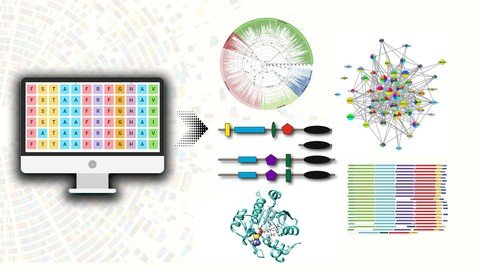
Free Download De-Novo Proteomics Data Analysis For Bioinformatics Research
Published 4/2024
MP4 | Video: h264, 1920x1080 | Audio: AAC, 44.1 KHz
Language: English | Size: 2.52 GB | Duration: 3h 45m
Learn the best of proteomics data analysis from protein sequence retrieval to 3D structure prediction and much more!
What you'll learn
Fundamentals of proteomics and bioinformatics
Techniques for data retrieval from proteomics databases
Analysis of protein domains, motifs, and structures
Integration of proteomics data into phylogenetic analysis
Understanding protein-protein interactions and network analysis
Prediction and modeling of protein 3D structures
Application of proteomics in disease research and biomarker discovery
Emerging trends and future directions in proteomics research
Requirements
Familiarity with basic concepts in molecular biology, genetics, and bioinformatics
Prior knowledge of bioinformatics tools and databases
Strong analytical and problem-solving skills
Motivation and commitment to learning advanced concepts in proteomics and bioinformatics
Description
Start a journey into the dynamic field of bioinformatics with this comprehensive course on De-Novo Proteomics Data Analysis. This meticulously crafted program is tailored to equip you with the essential knowledge and practical skills needed to excel in the intricate domain of proteomics data analysis.In the introductory segment, you'll receive a comprehensive overview of proteomics and bioinformatics, tracing the historical development of proteomics and exploring its significance and wide-ranging applications in the field. Delve into the challenges and limitations inherent in proteomics data analysis, laying the groundwork for a deeper understanding of the subject. You'll also be introduced to the fundamental concepts of De-Novo proteomics data analysis, setting the stage for an immersive learning experience.The course proceeds with an exploration of proteomics data retrieval, where you'll learn to navigate and leverage various proteomics databases such as UniProt and NCBI. Master data retrieval techniques including keyword searches and BLAST queries, and gain insights into advanced search strategies and data integration methods essential for handling large-scale data retrieval challenges effectively.Moving forward, you'll delve into the fascinating realm of protein domains and motifs prediction. Understand the structural and functional significance of protein domains, and learn to predict and analyze conserved domains and motifs using cutting-edge tools and algorithms such as Pfam, SMART, and InterProScan. Through engaging case studies, you'll unravel the functional implications of predicted domains and motifs in proteomics research.The course further explores the intersection of phylogenetics and proteomics data analysis, where you'll gain proficiency in integrating proteomics data into phylogenetic analysis and uncovering evolutionary insights from proteomics data. You'll explore comparative proteomics methodologies and delve into phylogenomic approaches for genome-scale phylogenetics, enriching your understanding of evolutionary relationships and dynamics.A highlight of the course is the in-depth exploration of network proteomics, focusing on protein-protein interactions. From understanding protein interaction networks to mastering experimental and computational techniques for protein-protein interaction prediction, you'll gain valuable insights into network analysis metrics and functional annotation strategies crucial for deciphering complex biological pathways.Next, you'll immerse yourself in the fascinating world of protein 3D structure prediction, learning the principles of protein folding, stability, and structure prediction methodologies. Through hands-on exercises, you'll master homology modeling and ab initio methods for predicting protein structures and explore their diverse applications in drug discovery and design.Finally, the course culminates with an exploration of proteomics and disease research, where you'll uncover the pivotal role of proteomics in disease biomarker discovery, clinical diagnostics, and systems biology approaches to disease understanding. You'll explore emerging trends and future directions in proteomics for disease research, equipping you with the knowledge and insights to drive innovation and make meaningful contributions to the field.Join us on this transformative journey as we unravel the complexities of De-Novo Proteomics Data Analysis, empowering you to unlock new insights and advance discoveries in bioinformatics research. Enroll now! and begin a rewarding exploration of proteomics data analysis.
Overview
Section 1: Introduction
Lecture 1 Introduction
Lecture 2 Overview of Proteomics and Bioinformatics
Lecture 3 Importance and Applications of Proteomics in Bioinformatics
Lecture 4 Challenges and Limitations in Proteomics Data Analysis
Section 2: Proteomics Data Retrieval
Lecture 5 Introduction to Proteomics Databases
Lecture 6 Data Retrieval Techniques ft. BLAST
Lecture 7 What are Gene families and Protein Families
Lecture 8 Handling Large-Scale Data Retrieval Challenges
Section 3: Protein Domains and Motifs Prediction
Lecture 9 Understanding Protein Domains and Motifs
Lecture 10 Protein Domain Prediction Methods
Lecture 11 Analysis of Conserved Domains
Lecture 12 Analysis of Conserved Motifs
Section 4: Phylogenetics and Proteomics Data
Lecture 13 Basics of Phylogenetics
Lecture 14 Proteomics Data for Phylogenetics
Lecture 15 Sequence Alignment
Lecture 16 Phylogenetic Tree Construction
Lecture 17 Phylogenetic Algorithms
Lecture 18 Tree Visualization and Annotation
Lecture 19 Evolutionary Insights from Proteomics Data and Phylogenetic Analysis
Section 5: Network Proteomics (Protein Protein Interactions)
Lecture 20 Introduction to Protein Interaction Networks
Lecture 21 Computational PPI Prediction Technique (STRING)
Section 6: Protein 3D Structure Prediction
Lecture 22 Principles of Protein Structure Prediction
Lecture 23 Homology Modeling Method of Protein Structure Prediction
Lecture 24 Ab Initio Method of Protein Structure Prediction
Lecture 25 Model Evaluation and Quality Assessment
Lecture 26 Ramachandran plot
Lecture 27 Applications of Predicted Structures in Drug Discovery and Design
Section 7: Proteomics and Disease Research
Lecture 28 Role of Proteomics in Disease Biomarker Discovery
Lecture 29 Clinical Proteomics: Diagnostic and Prognostic Applications
Lecture 30 Omics Integration: Genomics, Transcriptomics, Proteomics
Lecture 31 Systems Biology Approaches to Disease Understanding
Bioinformatics students seeking to specialize in proteomics research,Researchers and professionals in the field of molecular biology, genetics, and bioinformatics,Students and professionals interested in understanding the intersection of computational biology and proteomics
Homepage
Recommend Download Link Hight Speed | Please Say Thanks Keep Topic Live
No Password - Links are Interchangeable






